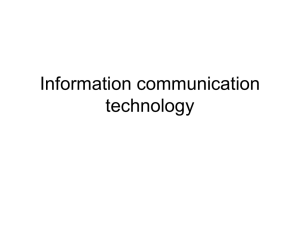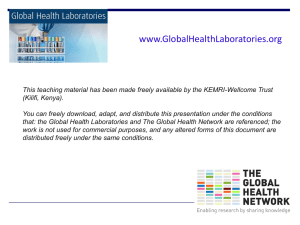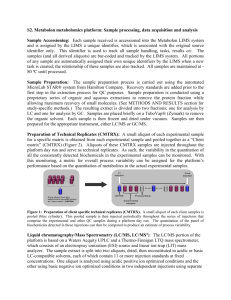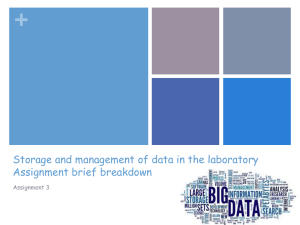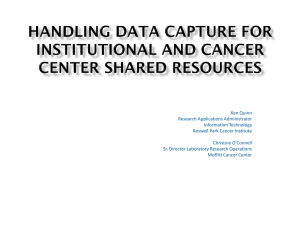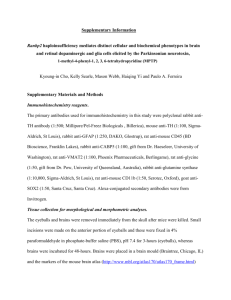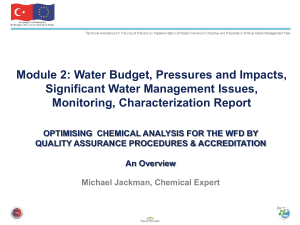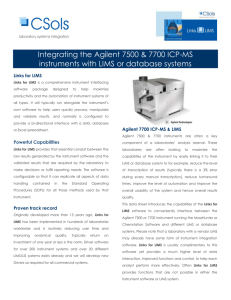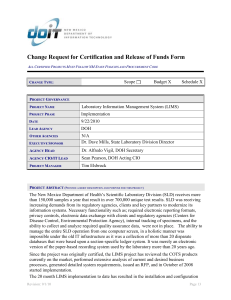Is there life after LIMS?
advertisement
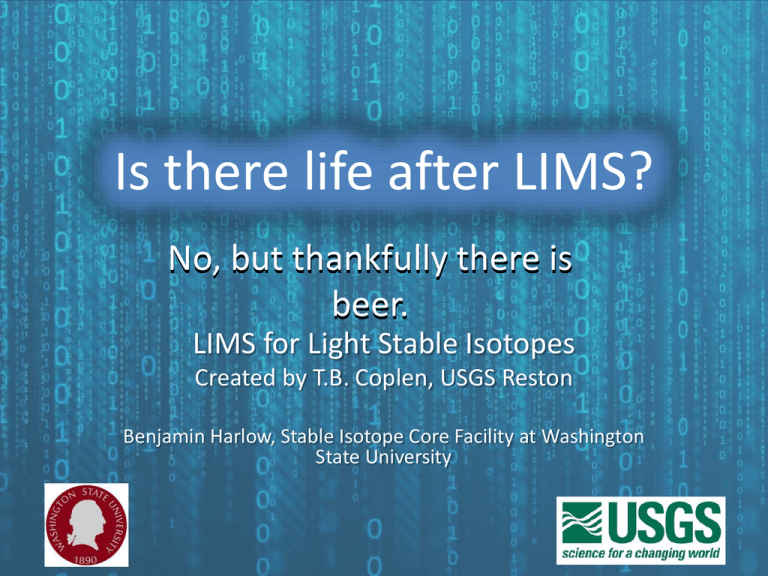
Is there life after LIMS? No, but thankfully there is beer. LIMS for Light Stable Isotopes Created by T.B. Coplen, USGS Reston Benjamin Harlow, Stable Isotope Core Facility at Washington State University Is LIMS for you? • Do you process >100 samples per year? • Do you process samples for multiple clients? • Do you measure multiple isotopes? • Do you use more than one instrument? Is LIMS for you… • Do you already have a database or spreadsheets that work for you? • LIMS by the USGS is not the only way to go • LIMS by the USGS is the most readily available, supported, and FREE software for Light Stable Isotopes • If yes, start sooner rather than later! Thankfully there is beer. Benefits to using LIMS • All your information in one place • Rapid and consistent treatment of data • Hourly drift corrections from multiple standards • Linearity correction • Data revision and safeguards • Powerful search, average and export functions • Report and Invoice generation Limitations • Can only have as many mass spectrometers or lasers as letters in the English alphabet • Normalization by linear regression is all that is currently possible • Some data manipulations may still be required via spreadsheet, etc. prior to importing First things first • MS Access supported versions – MS Office 2007, 2010, 32 bit only • Required Security settings – Add LIMS backend database to “trusted locations” – Enable all macros Set trusted locations, macros Setup • 3 folders, 4 files: – Backend DB (LM8DATA.mdb) – Frontend DB (LIMS9 for office 2010.mdb) + Preferences file – Backup • Back up Backend DB often! • Back up Preference files periodically (especially for new Front end versions) • Different users can have their own front end and preferences • Can install on one computer, network, cloud • WSU: dropbox; share DB with 7 computers (2 RAID), multiple smartphones Projects View projects, print reports, and export data to Excel Import project data from Excel forms Create new projects Add new clients Special Features Add new instruments Add or edit laboratory standards Backup and customize the database Design analysis templates Add or edit media or procedures Sample Information Create sequence files that can be imported into mass spectrometers Search, view, print and edit specific client samples Search, view, and edit extractions Analyses in Progress Import IRMS or LAS data Determine and apply blank corrections and drift corrections Normalize results to isotope scales View or edit isotope results Print or save isotope results to Excel files Evaluate results and track laboratory QA/QC Store final accepted results for reporting Import project to LIMS • • • • • • Manual entry or Excel spreadsheet Concept of “placeholders” Adjusting the next “Our Lab ID” Reference ID’s often set as a low number Example: References <1000, samples >1000 Keeps all references in one area of the sample table Enter new clients manually before creating the first project for that client Adding a project manually Date, Name, Media is the minimum information needed More information is better; i.e. project title and account are good to reference later Do not enter duplicate ID’s and avoid special characters for sample IDs Submit to LIMS • Simple excel templates are available for modification • Reduces typographical errors and valuable time of lab members • More information is good • Be unique, but avoid special characters $/\@#$%^&*! Sample excel submission form • • • • Customize to your lab: Letterhead, graphics, captions Captions must match exactly to what you defined in “special features” Use different forms for different types of samples Protect certain cells to reduce customer “tinkering” Other features • Track lab extraction procedures – Make notes about sample prep – Created primarily for offline procedures • Create labels for samples • Use templates to create run sequences of samples and references Selling (to) yourself • Create a “client” entry for your lab tests and reference material • We use “reference” and “test” • All international, commercial, and lab developed reference material is logged here • Reference lab ID’s get defined in reference table: Automatically fit in a normalization • Test lab ID: treat as a blind sample (Quality Control) IRMS/software setup • Machine must use sequential analysis number, with single letter prefix (ex: A-number) • Isodat: Configurator > Options > Global settings • Enter old analyses or those without prefix: “concatenate” function in excel • Note analysis number if you ever restore IRMS software! Know your media • • • • KISS IT More classifications can be useful Can add more at any time Tailor specific to your lab Media • Media originally designed for 2 isotopes only! • It is possible to store, edit and average 4. • How? Stay tuned Procedure Codes Low and High procedure Codes Running samples • LIMS ID# “Our lab ID” is most important identifier to use in sample sequences • Use LIMS template or design your own in excel • Template: LIMS automatically designs sample sequence Other features: Creating a sample list/template Another way to make a run sequence • Import excel file and generate LIMS ID’s • Copy/Paste sample information into a blank tab of the submission worksheet •Insert rows for running standards and QC’s • Can customize to instrument service state, sample types, desired timing, etc. Then you run the samples What Paul said… Exporting results and importing to LIMS • Must export specific column headings required by LIMS • Line #, Analysis #, time code, gasconfig, area, peak#, identifier 1, delta columns, is ref, comment, Rt • All peaks for reference gas must be marked “Is Ref = 1” or removed • Perform data preprocessing before importing (i.e. your own linearity, drift or mass fraction corrections) Export tips • Isodat: If a project got created with some special character, don’t export that column • Check chromatographs prior to exporting. Is reprocessing necessary? • Garbage in garbage out Importing data Option to apply linearity correction at this point 3 point normalization example Add elemental and blank corrections Normalize std gasses and data • Seldom used • Must import and properly code ref gasses • Provides option to salvage data Applying an hourly drift correction Use drift from any single standard Override: combination of all accepted standards, or custom Apply two drifts: must break up the sequence into two corrections Evaluating/editing samples in progress Mean, SD and outlier information Note: When samples are “in progress” mean, SD are available Some may choose to report at this point Rapid tracking of QC/QA Export full results for samples Store final results Stores a single value from all accepted reps Marks samples as completed Provides an extra layer of protection to data Necessary to use LIMS report function Add stored results to in process Unlocks samples for editing Can be done at any time Store function may be unnecesary for some users Storing an additional isotope or other numeric data • The “comment” field now averages numeric values and allows editing • The high and low comment provide two additional storage points • Include data calculated by a different detector, i.e. CNHOS% • Use with procedures that generate data for more than two isotopes, i.e. thermal conversion of N2O. Invoice generation and payment tracking Can I use LIMS for GCC-IRMS? • Yes you can! • Treat each vial as a project and target compounds are samples in the project • Use Rt or component ID feature in LIMS (extraction ID, Comment, Rt) • Internal standards should be in each vial Can I use LIMS for GCC-IRMS? • Alternative method: Modify file to import • Sort by component (Rt) and time code • Assign the same analysis number • Create unique peak number for every compound in a sample Can I use LIMS for Lasers? • Yes you can! • See Len Wassenaar’s session on Wednesday More Advanced • Open the tables and look in there • Cut, copy, paste; but watch for linked tables • Make your own queries Lab specific queries • • • • Annual reports, audits and cost evaluations # days runtime/machine/peripheral/Fiscal year # samples/machine/peripheral/year Count of customers by country, state, institution, and break down by sample type • # of samples billed by type • Average turnaround by sample type • Long term QC/QA Lab specific queries • • • • Annual reports, audits and cost evaluations # days runtime/machine/peripheral/Fiscal year # samples/machine/peripheral/year Count of customers by country, state, institution, and break down by sample type • # of samples billed by type • Average turnaround by sample type • Long term QC/QA Questions? What if… • I need to delete a project • I entered the wrong media code • I can’t find my samples in LIMS
